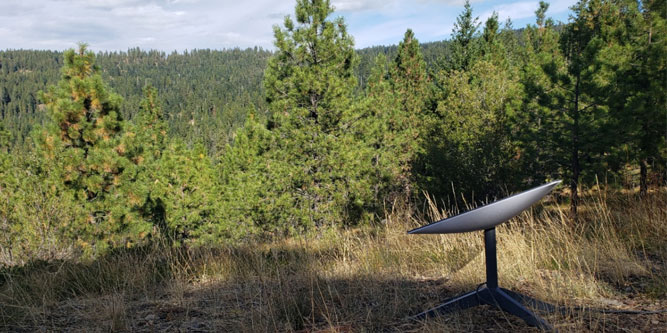Starlink internet is taking the world by storm. Their swarm of 2,300 satellites currently serves over 300,000 subscribers. Every month, they add more satellites to the swarm, allowing them to serve more customers in more places. But what’s the difference between Starlink and traditional satellite internet?
The difference is that traditional satellite internet relies on fewer, larger satellites. This leads to inconsistent connections as satellites come in and out of view. It also puts significant limits on your bandwidth.
Starlink solves this problem by using larger numbers of smaller satellites. Their system provides a more stable signal and higher speeds. If you live in a remote rural area, it’s the fastest internet around. And if you live off-grid in a van or RV, it may be your only practical internet option.

Best Starlink Portable Power Station
For off-grid use, you’re going to need a portable power station to run your Starlink equipment. The good news is that Starlink’s antenna and router draw an average of around 45 to 75 watts.
The exact load will depend on your signal strength and level of activity. When the connection is idle, the power demand can drop to only 20-30 watts. In other words, most power stations will meet the minimum requirements. But which one should you choose?
We’re about to review four of the best portable power stations for Starlink. We primarily looked for power stations that are as reliable as possible. But along the way, we looked at all of their other features.
Best Overall: EcoFlow Delta Max 2000 Portable Power Station
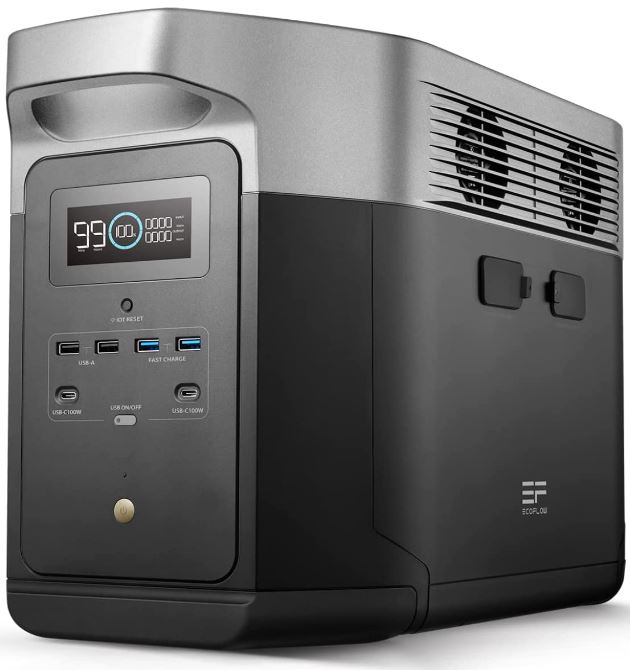
Key Features:
- 2,016Wh capacity.
- Powers Starlink for 24-48 hours.
- 2,400W maximum power delivery.
- Charges 15 devices at once.
- Modular system can be expanded.
EcoFlow is one of the leading names in the power station business. Among their other offerings, we recently reviewed the EcoFlow River Mini. It’s an ultra-compact power station with wireless charging, and it works very well for what it is.
For a Starlink power station, we looked at one of their larger models, the EcoFlow Delta Max 2000. This power station has a beefy plastic housing. It measures 19.6 inches wide, 9.5 inches deep, and 12 inches tall. The bulk of the housing is a matte black, but the upper portion is a grey. There are two handles molded into the sides of the top, and you’re going to need them. This bad boy tips the scales at a hefty 48 pounds.

At one end of the housing is an LCD display. This display shows your battery level both as a percentage and as a visual ring. It also shows your incoming and outgoing wattage, as well as your estimated time remaining. Your estimated time will change on the fly as you plug or unplug devices.
There’s a set of USB ports underneath the display. The two to the left are ordinary USB, and the two to the right with the blue tabs provide a faster charge. Beneath these is a pair of two USB Type-C ports. A small grey button with an LED indicator turns the USB ports on or off. There’s a main power button further down on the side to control the entire power station.
On the opposite side of the housing, you’ll find six grounded AC outlets. There’s also a DC automotive outlet and a pair of barrel-style DC outlets.
EcoFlow provides a three-year warranty for the Delta Max 2000. This gives us a lot of confidence in its long-term reliability.
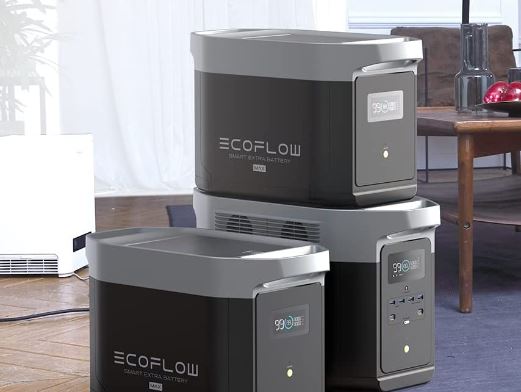
Capacity and Charging Capabilities
The Delta Max 2,000 has a battery capacity of 2,016 Watt-hours (Wh). That’s a significant amount of power – enough to run a 1,000-watt griddle for two hours. Even if your Starlink system is drawing a blazing 75 watts, it will be able to run for 26 hours straight.
You can also use this power station for larger devices. It has a maximum power delivery rate of 2,400 watts. It will only be able to keep that up for about 50 minutes. But still, you can use it for way more than just your Starlink system. More to the point, you can charge your phone or laptop without putting a dent in your maximum wattage.
When it comes time to recharge the batteries, you can use an AC power cord, automotive cord, or solar panel. The fastest method is to use EcoFlow’s Smart Generator with a solar panel.
Theoretically, you’ll be able to get 3,400 watts of charging speed. For most people, it will be easiest to recharge from a wall outlet. Using that method, it will charge from 0 to 80% in 65 minutes. Fully charging the battery takes about an hour and 45 minutes.
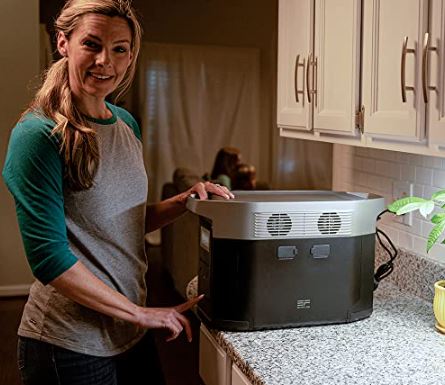
As an added benefit, the Delta Max 2000 is actually a modular system. You can combine up to three of them together, and they stack neatly one on top of another. This kind of three-stack setup can carry a whopping 6,048Wh of capacity. The power stations link via a pair of ports on the back of the housing. The linking cables, as well as AC and automotive charging cables, are included in the kit.
What We Liked:
- Massive capacity and power output.
- Charge up from 0-80% in 65 minutes via AC.
- Can be expanded to triple the power capacity.
- Long-lasting design and three-year warranty.
- Charges/powers up to 15 devices at once.
What We Didn’t Like:
- Big, bulky, and expensive.
Best Runner-Up: Anker 757 Portable Power Station
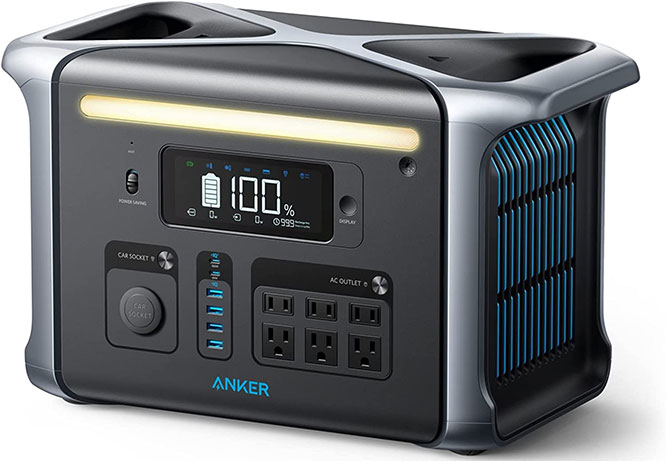
Key Features:
- 1,229Wh capacity.
- Powers Starlink for around 18-24 hours.
- 1,500W maximum power delivery.
- Charges 13 devices at once.
- Works as an uninterruptable power supply.
The Anker 757 Portable Power Station has a black and grey housing, with molded handles at the top sides. It’s roughly the same size and weight as the Delta Max, so these handles are much appreciated. The sides are vented to allow for plenty of air flow.

The front sports an LCD screen with all the data you could ask for. There’s also a lantern bar across the top, with a separate control button.
At the bottom left, you’ll see an automotive power outlet. In the bottom center, the USB ports are arranged in a column. The top two are Type-C ports, and deliver 100 and 60 watts. The next four are standard Type-A ports, with blue inner tabs for visibility. Finally, there are two rows of three AC outlets at the bottom right. The top row of outlets is un-grounded, and the bottom is grounded.
Best of all, you get a 5-year warranty. That’s the longest warranty on today’s list.
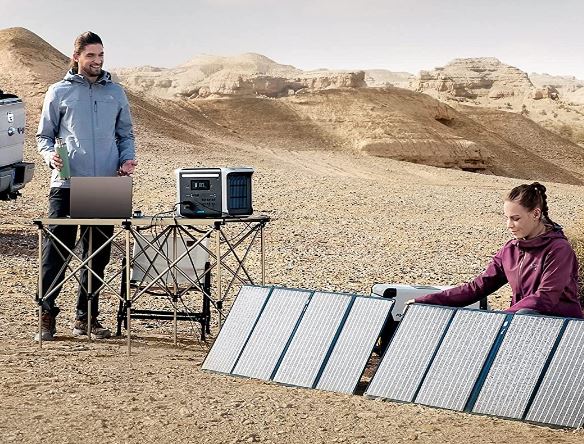
Capacity and Charging Capabilities
The Anker 757 has a capacity of 1,229Wh and a maximum power delivery of 1,500 watts. The AC charger is exceptionally fast. You’ll get an 80% charge in an hour, and a full charge in about 90 minutes. Alternatively, you can use any solar charger with a standard cable.
The internal LiFePO4 cells are rated for 3,000 duty cycles. That’s enough for several years of use before you start to notice a drop in capacity. In addition, the Anker 757 doubles as an uninterruptable power system (UPS). While plugged in, if the power goes out, it will instantly kick in and keep powering your devices.
What We Liked:
- Six AC outlets.
- Impressive battery cycle rating.
- Doubles as a UPS for CPAPs and other essential devices.
- Recharges to 80% in just 1 hour via AC.
What We Didn’t Like:
- Big, bulky, and a bit pricey.
- Cannot be expanded like the EcoFlow Delta.
Best Alternative: Jackery Explorer 1000 Portable Power Station
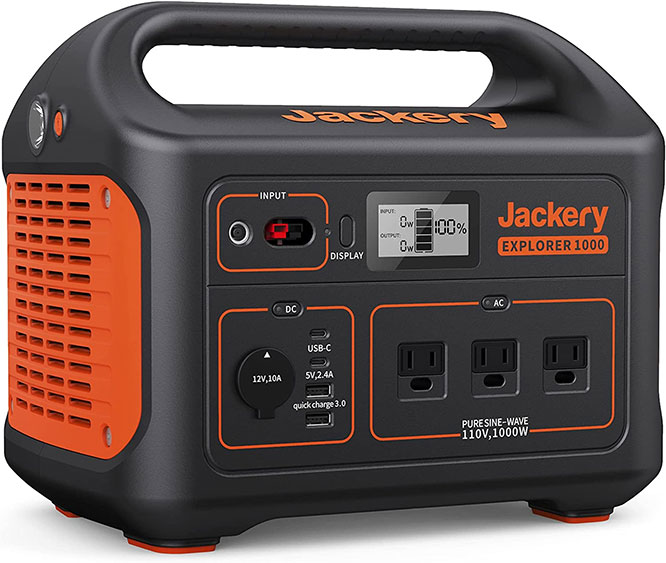
Key Features:
- 1,002Wh capacity.
- Powers Starlink for around 12-18 hours.
- 1,000W maximum power delivery.
- Charges/powers up to 8 devices at once.
Jackery is well-known for their Explorer line of power stations. In fact, we’ve reviewed the Jackery Explorer 1500, which is the larger version of today’s offering.
The Jackery Explorer 1000 has a black plastic housing with orange vented side panels. It measures 13.1 inches wide, 9.2 inches deep, and 11.1 inches tall including the molded handle. At 22.05 pounds, it’s light enough to carry around in one hand.
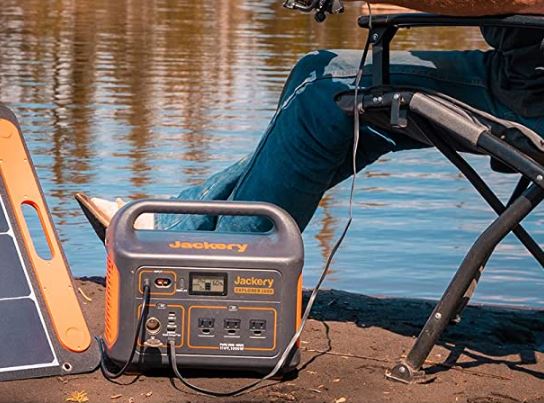
On the front panel of the housing is an LCD display, which shows your charger’s current status. To its left are AC/DC charging and solar inputs for charging.
Along the bottom, you’ll find all your other ports. There’s a DC automotive outlet, along with a pair of USB Type-C ports. There are two USB Type-A ports, one of which offers QC 3.0 fast charging. At the right is a row of three AC outlets. The automotive outlet, USB outlets, and AC outlets each have their own group control button.
Another thing we should note is the flashlight on the left side of your housing. Because of this positioning, you can hold the power station at your side and use it as a lantern. Furthermore, it won’t blind you when you want to read the LCD display.
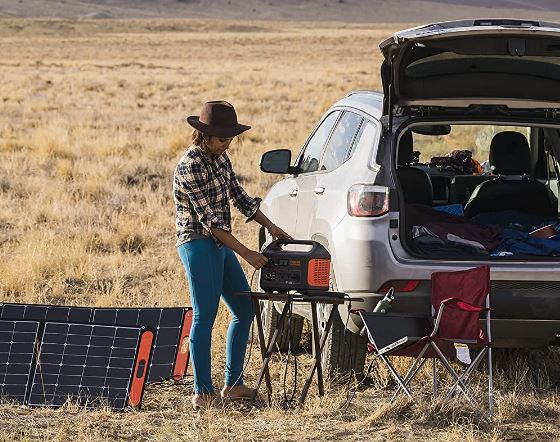
Capacity and Charging Capabilities
Thanks to its large vents, the Explorer 1000’s fans run very quietly when it’s in operation. At full power, it can deliver a maximum of 1,000 watts. And with a capacity of 1,002Wh, it can keep that up for about an hour. It will charge in about 5 ½ hours from your wall outlet, or 11 ½ hours in a car. You can also use a solar panel.
This power station supports pass-through charging. This means you can use it while it’s being charged without damaging the battery. On the downside, the battery itself is only rated for 500 duty cycles. Unfortunately, Jackery utilizes a bit older battery technology. As a result, it’s only rated for approximately 500 duty cycles before its capacity may diminish.
What We Liked:
- Tough, rugged design.
- Supports pass-through charging.
- Light is in the side of the housing, not the front.
- Very quiet operation.
What We Didn’t Like:
- Low battery cycle rating.
- Slow AC recharge times.
- Outdated battery technology with only 500 duty cycles.
Best Budget: EcoFlow River 600
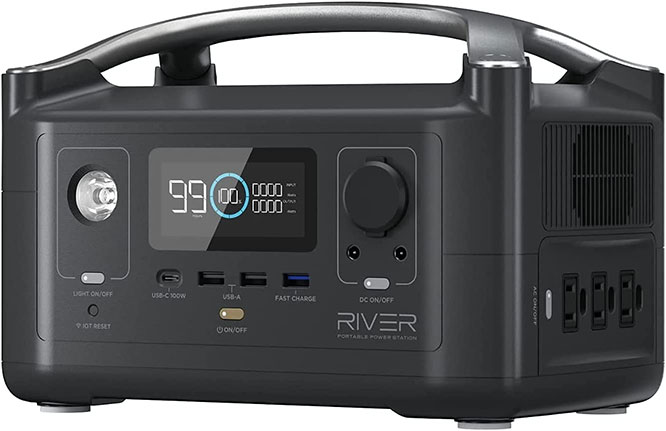
Key Features:
- 288Wh capacity.
- Powers Starlink for up to 5-8 hours.
- 1,800W maximum power delivery.
- Charges/powers 10 devices at once.
The EcoFlow River 600 is a much more affordable option. This power station has a black plastic housing that measures 11.7 inches wide, 7.3 deep, and 7.7 tall. The height includes an X-shaped handle, which makes it easy to carry the light, 11-pound device.

The front of the housing has a spotlight at the left side, with its own on/off button. An LCD display in the center shows a battery meter, as well as incoming and outgoing power levels.
The DC power port is located to the right of the display, along with a pair of barrel-shaped DC outlets. Directly beneath the display is a row of USB ports, starting with a single Type-C port. Following that are two ordinary Type-A ports and a Type-A QC port. The three grounded AC outlets are located on the right side of the housing.
Capacity and Charging Capabilities
The 288Wh capacity is enough to run a Starlink system at full capacity for a little under five hours. And with 1,800 watts of electrical current and pure sine wave AC power, you can power just about any device.
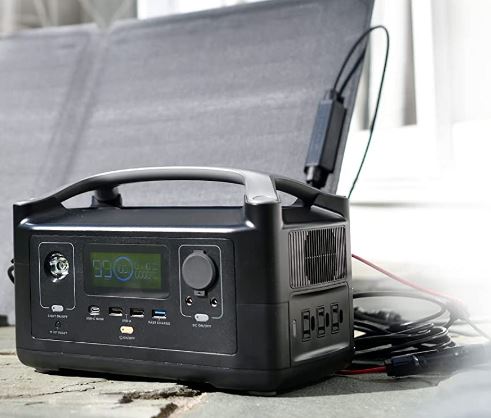
There’s a flip-up panel on the left side of the housing that covers the charging inputs. You can fully charge the River 600 from a wall outlet in as little as 1.6 hours, or 3.5 hours on a car outlet. You can even charge via solar, and all the cables are included.
What We Liked:
- Lightweight, portable design.
- Very fast charging.
- Surprisingly high maximum wattage.
- Affordable.
- Fairly lightweight.
- Expandable battery capacity.
What We Didn’t Like:
- Relatively low capacity.
Final Thoughts on the Best Portable Power Station for Starlink
So, which of these portable power stations for Starlink is right for you? Here’s what we thought about each one.
The EcoFlow Delta Max 2000 is undeniably the overall best portable power station for Starlink. With over 2,000Wh of capacity and super-fast recharge times, it offers near-unparalleled power and enough capacity to run Starlink for 1-2 days straight. And with its modular design, you can triple your capacity at any point in the future. It’s quite expensive, but if you’re willing to pay for the best, this is it.
The Anker 757 is slightly more affordable. Although it doesn’t deliver as much power, it’s still pretty robust. It can power the Starlink dish and router for around 18-24 hours. Best of all, it boasts a super fast AC recharge time, just like EcoFlow’s offerings. Moreover, the UPS function makes it one of the more versatile power stations out there.
The Jackery Explorer 1000 is a great alternative choice. It’s not quite as powerful as the Anker, but it’s still pretty robust. While it doesn’t recharge as fast as the other options, it has enough capacity to operate Starlink for about 12-18 hours. However, the battery technology is slightly outdated, with less projected duty cycles than the other options.
The EcoFlow River 600 is the most affordable of the bunch. And while it’s not absurdly powerful, it’s more than reliable enough for your Starlink equipment. Perfect for day trips with enough capacity to power Starlink for around 5-8 hours. Best of all, it re-charges incredibly fast, just like their bigger model, the Delta Max.
Meet Ry, “TechGuru,” a 36-year-old technology enthusiast with a deep passion for tech innovations. With extensive experience, he specializes in gaming hardware and software, and has expertise in gadgets, custom PCs, and audio.
Besides writing about tech and reviewing new products, he enjoys traveling, hiking, and photography. Committed to keeping up with the latest industry trends, he aims to guide readers in making informed tech decisions.

